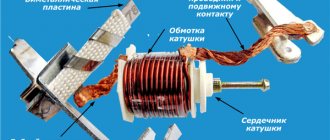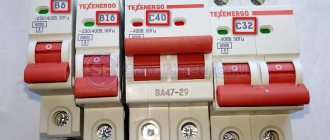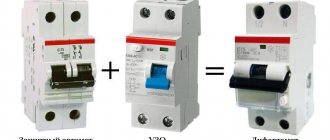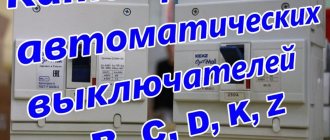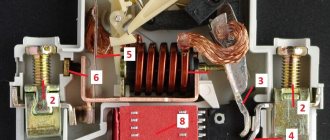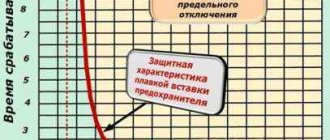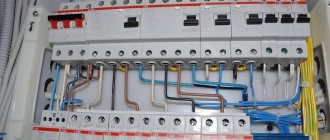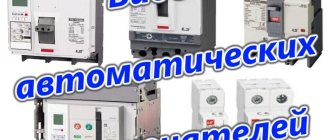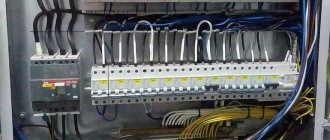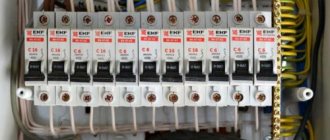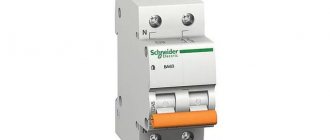High current categories:
1) over short circuit currents, when the neutral and phase conductors are directly connected to each other, bypassing the load.
Modern electromagnetic releases easily and completely accurately detect short circuits and disconnect the load in a fraction of a second, preventing even the slightest damage to conductors and equipment.
2) large currents caused by network overload (for example, the inclusion of a large number of household electrical appliances, or the malfunction of some of them);
The overload current is not much different from the rated current; for some time it can flow through the circuit without any consequences. Therefore, there is no need to turn off such current instantly, especially since it could arise very briefly. The situation is aggravated by the fact that each network has its own overload current limit. And not even alone.
Unacceptable mistakes when purchasing
The most common mistakes when choosing and purchasing an input circuit breaker are ignorance of the principles of its operation and choosing a machine rating lower or higher than the required value. If you choose a machine with a lower rating, then it is possible that the protection will trigger falsely and shut down the entire apartment due to one device. If you select a rating higher than the required value, it may work after the wire insulation or devices inside the electrical panel overheat and begin to melt or burn.
There are also “professionals” who connect two single-pole circuit breakers instead of a two-terminal circuit, not knowing that this violates electrical safety requirements and the PUE prohibits such a connection.
If you have doubts about the selection and installation of such a device, you should contact a professional electrician and rest assured that the correct choice and safe installation.
Device of automatic switches. Types of releases.
1) mechanical – for manual switching on and off,
2) electromagnetic (solenoid) – to disconnect short circuit currents,
3) thermal for overload protection.
The characteristic of thermal and electromagnetic releases is the characteristic of the circuit breaker, which is indicated by a Latin letter on the body in front of the number indicating the current rating of the device.
The characteristics of circuit breakers mean:
a) the operating range of overload protection, determined by the parameters of the built-in bimetallic plate, which bends and breaks the circuit when a large electric current flows through it. Fine adjustment is achieved by an adjusting screw that tightens this very plate;
b) the operating range of the overcurrent protection, determined by the parameters of the built-in solenoid.
Connection instructions
Before talking about the procedure for connecting a 16-amp machine, you should understand the main structural elements of the device. It consists of:
- Top contact clamp.
- Bottom terminal.
- Shift knobs.
- Electromagnetic release.
- Thermal (bimetallic) break contact.
How to understand the colors of wire cores Source markevich.by
Characteristics of modular circuit breakers
There are a number of currents, for each of which it is theoretically possible to determine its maximum network shutdown time, ranging from several seconds to tens of minutes. But false alarms must also be excluded: if the current is harmless to the network, then a shutdown should not occur either after a minute, or after an hour - never at all.
1) MA – absence of thermal release. In fact, it is really not always needed. For example, protection of electric motors is often carried out using overcurrent relays, and in such a case the machine is needed only for protection against short circuit currents.
2) Characteristic A. The thermal release of the machine with this characteristic can operate already at a current of 1.3 of the rated current. In this case, the shutdown time will be about an hour. At a current twice the rated current, an electromagnetic release can be activated, operating in approximately 0.05 seconds. But if at twice the current the solenoid still does not operate, then the thermal release still works, turning off the load after about 20-30 seconds. At a current 3 times higher than the rated current, the electromagnetic release is guaranteed to operate in hundredths of a second.
Automatic circuit breakers of characteristic A are installed in those circuits where short-term overloads cannot occur in normal operating mode. An example would be circuits containing devices with semiconductor elements that can fail if the current is slightly exceeded.
3) Characteristic B The characteristic of these machines differs from characteristic A in that the electromagnetic release can only operate at a current exceeding the rated current by 3 or more times. The solenoid response time is only 0.015 seconds. When machine B is overloaded three times, the thermal release will operate in 4-5 seconds. Guaranteed operation of the machine occurs at a 5-fold overload for alternating current and at a load exceeding the rated load by 7.5 times in DC circuits.
Automatic switches of characteristic B are used in lighting networks, as well as other networks in which the starting current increase is either small or absent at all.
4) Characteristic C. This is the most familiar characteristic for most electricians. Machines C are distinguished by an even greater overload capacity compared to machines B and A. Thus, the minimum operating current of the electromagnetic release of the machine with characteristics C is 5 times the rated current. At the same current, the thermal release operates in 1.5 seconds, and the guaranteed operation of the electromagnetic release occurs at a 10-fold overload for alternating current and at a 15-fold overload for direct current circuits.
Circuit breakers C are recommended for installation in networks with mixed loads that require moderate inrush currents, which is why household electrical panels contain circuit breakers of this type.
Characteristics of circuit breakers B, C and D
5) Characteristic D – has a very high overload capacity. The minimum operating current of the electromagnetic solenoid of this machine is 10 times the rated current, and the thermal release can operate in 0.4 seconds. Guaranteed operation is provided at 20 times overcurrent.
Circuit breakers of characteristic D are intended primarily for connecting electric motors with high starting currents.
6) Characteristic K is characterized by a large spread between the maximum operating current of the solenoid in AC and DC circuits. The minimum overload current at which the electromagnetic release can operate is 8 times the rated current for these machines, and the guaranteed operation current of the same protection is 12 times the rated current in the AC circuit and 18 times the rated current in the DC circuit. The response time of the electromagnetic release is up to 0.02 seconds. The thermal release of the K machine can operate at a current exceeding the rated current by only 1.05 times.
Due to these features of the K characteristic, these machines are used to connect purely inductive loads.
7) Characteristic Z also has differences in the guaranteed operation currents of the electromagnetic release in AC and DC circuits. The minimum possible operation current of the solenoid for these machines is 2 times the rated current, and the guaranteed operation current of the electromagnetic release is 3 times the rated current for alternating current circuits and 4.5 rated current for the direct current circuit. The thermal release of Z machines, like those of K machines, can operate at a current of 1.05 of the rated current.
Z machines are used only for connecting electronic devices.
04.04.21
Marking of the machine
According to the PUE, each protection device must have an inscription indicating the value of the rated current. To find out the value of the machine, just look at its body. These protection devices use standard markings consisting of one letter (B, C or D) and a number.
The letter indicates the time characteristic. It is also called response time. This parameter will be discussed below. The number indicates the rated current of the device. For example:
- C25 - time characteristic C, rated current 25 A;
- B32 - characteristic B, 32 A.
In everyday life, switches with time characteristics B and C are usually used. In industry, protective devices from the L, Z and K series are found.
Additional Information. The marking also contains other information about the device. For example, series number, rated operating voltage, breaking capacity and number of poles.
Manufacturers and brands
Single-pole circuit breaker ABB 1P C25
Before choosing and buying a C25 circuit breaker, you should familiarize yourself with the companies that represent them and the price. Well-known instrument manufacturers:
- The Swedish-Swiss company ABB is rightfully considered the leader in the market of electrical products of this class.
- Circuit breakers from Legrand (France) are not inferior in quality to the previous brand, and the prices are approximately comparable in value.
- The products of another French company (Schneider Electric) are well known to domestic consumers, who speak highly of this product.
The price of a C25 assault rifle on the domestic market ranges from 100 rubles. up to 100 thousand rubles depending on the number of poles, company and brand.
How many sockets can be connected to one 2.5 square wire?
It should be noted right away that according to GOST R 53315-2009 in residential premises (apartments and private houses) it is allowed to make electrical wiring for sockets using VVGngLS copper cable with a cross-section of each core of 2.5 mm.sq.
Quite often, in two and even three-room apartments, 15-20 sockets are installed on such a cable coming from the distribution panel, and this is normal. You can “hang” as many sockets on one cable as you like, because they are not consumers of electrical energy and do not create a load on the cable. Each socket (even if several mechanisms are connected by a cable) with a reliable connection is only a conductor (as well as a cable).
The main condition for safe operation of the cable is that the total power consumption of consumers (electrical appliances, devices) that will be turned on simultaneously does not exceed the threshold value for a given cable.
The GOST cable with a core cross-section of 2.5 square is designed for long-term current transmission of 25-27A, which is equal to the power of electrical devices of 5.5-5.9 kW. Exceeding these values leads to heating of the conductor and, as a result, the possibility of a fire.
If you need to connect electrical appliances with a higher total power, it is recommended to divide the sockets into two or more lines. Each group is powered by a separate cable.
Today, with a large amount of electrical equipment, this principle is used in apartments and houses when designing and installing electrical wiring - separate lines are laid in the kitchen, bathrooms and living quarters (living room, bedroom, children's room...).
For energy-intensive electrical appliances, such as, for example, a boiler, washing machine, air conditioner, electric stove, oven... a separate line is laid and only one socket is installed or the device is connected directly to the electrical cable.
Each individual line or socket group must be protected by its own circuit breaker or circuit breaker.
Conclusion: an unlimited number of sockets can be connected to one cable with a cross-section of 2.5 square meters, provided that the total power of consumers connected to them will not exceed 5.5-5.9 kW. But as practice shows, it is better not to abuse maximum loads and leave 20% of the power reserve for the cable. This means that the maximum load on the cable will be 2.5 square – 4.4 – 4.7 kW.
